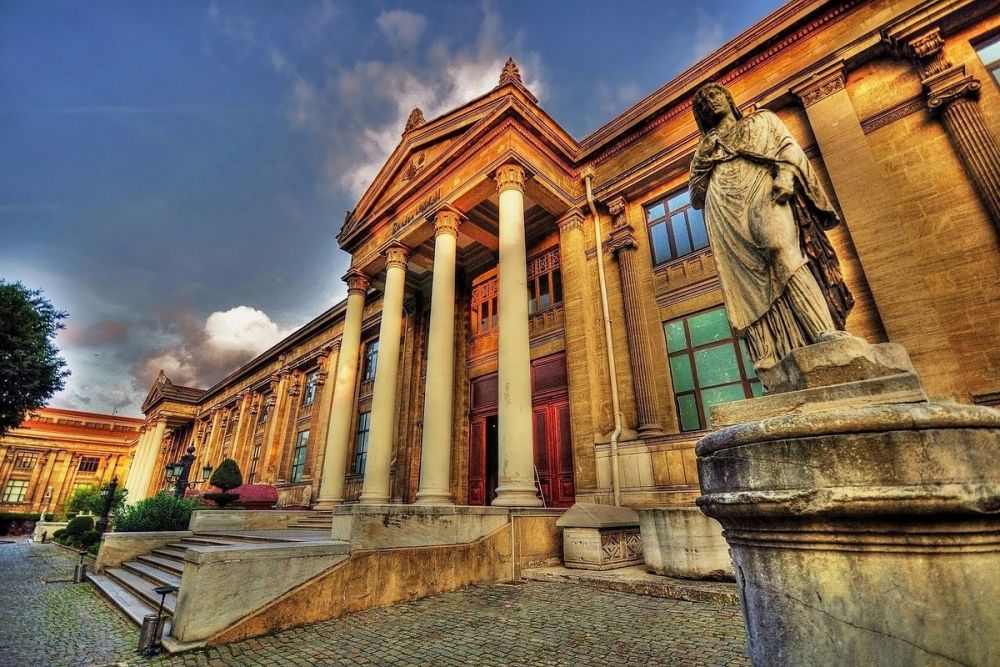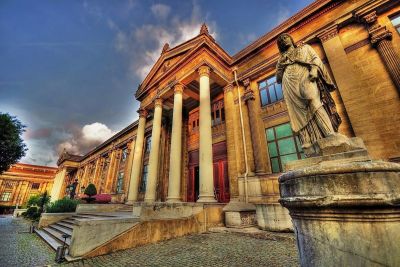

Explore the extensive collection showcased at the Ancient Orient section of the Istanbul Archaeology Museums. Here, you will be mesmerized by artifacts from ancient Mesopotamia, Anatolia, Egypt, and the Arabian Peninsula. The exhibition displays priceless pieces such as the Treaty of Kadesh—one of the oldest peace treaties in history—and the Ishtar Gate of Babylon. This curated journey provides deep insights into some of the earliest civilizations of human history. Every item has a story that together creates a comprehensive tableau of the ancient oriental world. As you walk through the halls, prepare to embark on a historical adventure that spans across centuries and showcases human civilization's early achievements in these cross-cultural cradles.
Upon entering the main building of the Istanbul Archaeology Museums, visitors will find themselves surrounded by an impressive collection of classical antiquities. This building, designed by the renowned architect Alexandre Vallaury, is home to a vast array of Greek, Roman, and Byzantine artifacts. As visitors wander through the galleries, they will come across stunning marble statues, intricately designed sarcophagi, and an array of ancient coins and jewelry. At the heart of the museum lies the captivating sarcophagus of Alexander the Great, which draws visitors from around the world. With each exhibit, the museum offers a unique glimpse into the ancient civilizations that once flourished around the Mediterranean. Knowledgeable guides and informational plaques provide context to these historic treasures, enriching the experience for history aficionados and casual visitors alike.
The Tiled Kiosk Museum, part of the Istanbul Archaeology Museums complex, is a marvel for lovers of Islamic art and architecture. Dating back to the Ottoman era and originally serving as a pavilion, the museum today showcases an exquisite collection of ceramic art and tiles ranging from the Seljuk period to the end of the Ottoman Empire. Visitors can admire the intricate designs, vivid colors, and craftsmanship that reflect the rich artistic heritage of the region. The museum's collection provides a unique opportunity to observe the evolution of ceramic and tile-making techniques through the centuries. Each piece tells a story of its time, blending functionality with artistic expression. The serene and beautifully designed Kiosk is an enchanting setting that compliments the art it houses, providing an immersive cultural experience in the heart of Istanbul.
Dive deep into the world of ancient burial customs and rituals with the Sarcophagi Exhibition at the Istanbul Archaeology Museums. This exhibition features a wide range of meticulously crafted sarcophagi spanning various eras and cultures, including Phoenician, Lycian, and Roman. The centerpiece of this collection is the splendid Lycian Sarcophagus, renowned for its detailed friezes depicting scenes from Greek mythology. As you explore the exhibition, you'll gain insights into the beliefs, ceremonies, and artistic achievements associated with the eternal journey of life after death. The sarcophagi, with their elaborate carvings and elaborate designs, offer a poignant window into the past, showcasing the artisans' dedication to honoring the deceased. This tour is a must for anyone interested in archaeology, art history, or the mystique of ancient civilizations.
Embark on a fascinating journey through time with the 'Istanbul Through the Ages' exhibition at the Istanbul Archaeology Museums. This comprehensive display takes you on a tour from the city's earliest settlements to its eventual transformation into the cosmopolitan hub of Byzantium and later, Constantinople. Marvel at the array of artifacts, including earthenware pots, ancient coins, and ornate Byzantine relics. Each exhibit piece offers its own narrative about the city's vibrant history, trade relations, cultural exchanges, and architectural marvels. Visitors will appreciate how the city's strategic location bridged continents and civilizations, shaping the unique heritage that defines Istanbul today. This exhibition is more than a mere collection of objects; it's a storybook that invites you to read the chapters of a city that has been at the crossroads of history for millennia.
The Coin Cabinet at the Istanbul Archaeology Museums is a hidden gem for numismatists and history enthusiasts alike. Boasting one of the most extensive collections of ancient coins in the world, the exhibition provides a unique perspective on economic history, iconography, and metallurgy. Visitors will be astonished by the variety of coins on display, ranging from early forms of currency to intricate pieces from the Ottoman Empire. The collection covers a chronological span from the 7th century BC to the 20th century, allowing visitors to observe the progression of coinage in design, material, and use across different eras and empires. Engaging displays explain the significance behind the symbols and inscriptions, offering insights into the political and cultural climate of the times. Exploring the Coin Cabinet is not just about observing currency; it’s about uncovering the stories and legacies embedded in these small but mighty artifacts.
The Children's Museum within the Istanbul Archaeology Museums complex is a creative and interactive space designed to spark curiosity among young minds. This special section of the museum is tailored to educate and entertain younger visitors through hands-on activities, workshops, and engaging exhibits that introduce them to the fascinating world of archaeology and history. The museum encourages children to experience the thrill of discovery, whether it's through a mock excavation pit, interactive puzzles, or storytelling sessions. It's an excellent way for families to spend time together, combining fun with learning, as children explore reconstructions of ancient environments and get up close with child-friendly replicas of artifacts. The Children's Museum is not just a space for play—it's a launchpad for the next generation of explorers and historians to develop their love for the past.
Experience a unique slice of history by visiting the replica of Ennigaldi-Nanna's Museum at the Istanbul Archaeology Museums. This fascinating reconstruction represents the world's oldest known museum, dating back to the 6th century B.C., founded by the Mesopotamian princess Ennigaldi. The replica brings to life the ancient museum that once stood in the city of Ur, presenting artifacts as they would have been displayed thousands of years ago. The exhibit creates an immersive atmosphere, allowing visitors to walk in the footsteps of Ennigaldi and witness firsthand the ingenuity behind one of the earliest attempts at preserving and cataloging historical objects. The detailed displays and informative plaques provide context, deepening the appreciation for the foresight of those who understood the value of preserving cultural heritage for future generations.
The Library of the Archaeological Museum, situated within the Istanbul Archaeology Museums complex, is an invaluable resource for those interested in archaeology, art history, and antiquities. Housing more than 70,000 books and periodicals, the library's vast collection provides depth and context to the museum's exhibitions. Rare manuscripts, maps, and an archive of documents are available to researchers and history enthusiasts who seek to delve further into the realms of the past. While the library is primarily used for academic research, it remains an integral part of the museum experience as it supports and enriches the understanding of the cultural and historical narratives presented throughout the museum's galleries. Visitors can appreciate the commitment to preserving not only physical artifacts but also the literature that interprets and studies them.
In addition to its permanent exhibits, the Istanbul Archaeology Museums often host a variety of seasonal temporary exhibitions that add an exciting dimension to the museum-going experience. These exhibitions showcase unique themes, unearthing different aspects of archaeological findings, historic periods, or cultural phenomena. Visitors can expect to see anything from special artifact collections, loaned exhibits from other museums around the world, or themed displays that align with significant historical anniversaries or current events. These exhibitions provide a fresh perspective and are designed to engage a broad audience, making each visit to the museum a novel experience. The temporary nature of these exhibits adds an element of exclusivity, as there is typically a limited timeframe in which to visit and enjoy these special displays.
